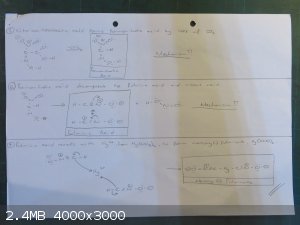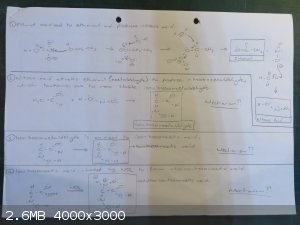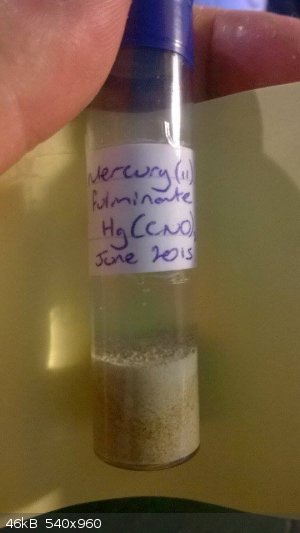edschembri
Harmless

Posts: 2
Registered: 23-5-2015
Member Is Offline
Mood: No Mood
|
|
Synthesis and Reaction Pathway of Mercury (II) Fulminate - Hg(CNO)2
Hi, this is my first post on Science Madness 
Recently I've been experimenting with the synthesis of mercury (II) fulminate, Hg(CNO)2, and I'd like to both share my progress and also ask a couple
of questions. I've posted this in the organic part of Science Madness because although the salt is inorganic, only the last step of its formation is
an inorganic reaction, with all the previous steps being fully organic.
Firstly, this is my method of preparation:
1. 0.5 mL Hg was dissolved in 5 mL cold 65% HNO3. After dissolution, the solution was swirled and gently blown to liberate any NO2 still dissolved in
it.
2. The solution was slowly poured into a round bottom flask containing 7.5 mL absolute ethanol. Immediately after, 6 mL cold 65% HNO3 and 12 mL
absolute ethanol were added, and put in a bath of boiling water. This resulted in a clear solution upon slight swirling. The solution was kept in the
boiling water bath till white vapour (smell like apples) filled the flask, the solution turned slight orange or grey, and the bubbling continued even
after being removed from the water bath. It was then removed from the water bath and allowed to stand. Light brown/grey/white crystals precipitated
out, along with a very small amount of elemental Hg. The reaction took between 20-30 minutes.
3. The crystals were washed in cold water, and stored in a vial under water.
Attached should be two images, of what I believe the reaction pathway is.
My questions:
1 - Upon adding the Hg(NO3)2/HNO3 solution to the ethanol, a white precipitate is formed, which after a few seconds turns orange/yellow. When this is
then put in the water bath, fulmination doesn't seem to happen. I experimented and found that if I add the 6 mL 65% HNO3 and 12 mL ethanol the
precipitate dissolves and fulmination occurs once put in the water bath. Does anyone know what this precipitate is and why it's forming?
2 - In the precipitate, were noticed a few, very fine, droplets of elemental Hg. Any ideas why this is happening?
3 - I've done this exact procedure around 3 or 4 times, and each time I get a slightly different coloured precipitate (still in line with the usual
colours of mercury (II) fulminate; grey, white, brown). Besides the chance of contamination, does anyone know why there's such variation in the colour
of the final product? (I've included a picture of my product, a mixture of the yields of each synthesis)
4 - Does my reaction pathway look probable? (excuse any silly mistakes in lone pairs and mechanisms; I'm still doing my bachelors so still am quite
the noob)
Thanks for your time, and hope this was of interest to someone
Ed Schembri
  
|
|
|
Marvin
National Hazard
   
Posts: 995
Registered: 13-10-2002
Member Is Offline
Mood: No Mood
|
|
The write up could do with some fleshing out. Neutralising and making inert the mercury in your waste for example. When I was your age I skipped
this step and wish I hadn't.
I would avoid making a trophy of your product, use it up outside. Even if you think you understand the risk and are happy with it your family,
friends and any pets didn't sign up for it. I kept half a gram of mine on the basis that it decays safe but 20 years on I simply don't know where it
is. I stored it dry. I was surprised how insensitive it seemed to be but I think I had a little sulphate contamination.
Most reactions we tend to look at as a synthesis, like the products want to form. We push arrows like there is an order and the molecules agree to
play by our rules. This for me is the best example that chemistry is messy. The hot mixture of nitric acid oxidises the ethanol to carbon dioxide
via a number of reactive products you've listed, which are present at low concentration in a sort of transient equilibrium. One fleeting species,
fulminate, is a pseudohalogen like cyanide. Some salts with halogens are almost insoluble in water, silver halides, mercury(I) chloride, mercury(II)
Iodide. Silver(I) and Mercury(II) fulminate turn out to be also almost insoluble. This for me is the key to why the product forms and why only with
those two elements. With silver or mercury in solution the transient species of fulminic acid in a high enough concentration precipitates,
substantially protecting it from further oxidation. If the reaction doesn't go fast enough you don't get the concentration to form a precipitate, if
the solution is left the product may be digested by the remaining acid.
The impurities are mostly polymerisation products and colloidal mercury (COPAE Davis IIRC) and will depend on circumstances like the temperature
profile and rate of the reaction. Blowing away nitrogen oxides after the dissolution step may retard the reaction. I'm a little too long out of the
game to check the detail of your reaction pathway but the outline looks in line with Davis, Sidgwick and Smith.
|
|
|
Dr.Bob
International Hazard
    
Posts: 2893
Registered: 26-1-2011
Location: USA - NC
Member Is Offline
Mood: Mildly disgruntled scientist
|
|
It is an interesting writeup, but might be better posted in energetic materials, that is where they can better evaluate this area. While fulminates
are organic, they are also very energetic.
|
|
|
Boffis
International Hazard
    
Posts: 1910
Registered: 1-5-2011
Member Is Offline
Mood: No Mood
|
|
The presence of gobules of mercury in the produce suggests that you haven't oxidized all of the Hg to mercuric ions. With small volumes of mercury
there is not enough heat generated to ensure complete oxidization so the resulting solution contains a little mercurous mercury. This is easily solved
by heating the solution to about 70 C and cooling back to the 30-40 C for fulminate preparation. With larger quantities of mercury >50g say there
is enough heat generated to ensure pretty complete oxidation on solution though I usually heat to 70 C or so for 20-30 minutes to ensure complete
oxidation and to expel the NO2.
My fulminate is alway a bit greyish even then. You can recrystallise mercury fulminate from a large amount of water but its tedious and messy. The
addition of a little copper has been discussed on this forum under other threads (UTFSE) and this is supposed to give a whiter product but for me the
presence of copper is unacceptable since the fulminate is a precursor to other compounds.
You can test for Hg+ in Hg2+ nitrate by diluting a single drop with about 10 drop of water and adding a few drops of dilute NaOH solution. If the Hg
is entirely mercuric (Hg2+) the precipitate is pure lemon yellow, even traces of mercurous ions generate an ochre yellow and then brownish and
eventually almost black precipitate with increasing mercurous ion concentration.
By the way the chemistry of fulminic acid is fascinating, extremely complex and bizzare. It gives access to an incredibly rich and diverse variety of
unusual and yet very simple organic compounds which are not readily available by other routes. And then there are its inorganic complexes which are
potentially as diverse as those of cyanide but have been little investigated due to their explosive nature.
|
|
|
edschembri
Harmless

Posts: 2
Registered: 23-5-2015
Member Is Offline
Mood: No Mood
|
|
Hey guys, sorry for the late reply, I didn't receive any emails saying there'd been replies to my post.
Marvin - Yep chemistry is extremely messy, especially at the novice stage that I consider myself to be in at the moment. Yep, I got most of my pathway
from Davis but tried to supplement from other sources as his ignores side reactions. Since this post I've done more research about this and dug a
little deeper. Yeah, I dont expose anyone other than myself to the harmful chemicals; they're either locked up and stored safely, or like in this
batch of fulminate's case, blown to smithereens. Cheers marvin
Dr. Bob - I think it's better suited in Energetic Materials too, I'll try move it there or just repost it if I can't, cheers doc
Boffis - I think that's it, I'll try the synth again keeping it at those temperatures. At first I though the HNO3 wasn't in excess and mercury I
nitrate was forming, then decomposing to HNO3 and Hg, but seeing as I add more HNO3 before I heat I didn't think it was probable. Very valuable,
thanks.
Thanks for the replies lads, appreciate them
|
|
|
Polverone
Now celebrating 23 years of madness
|
Thread Moved
20-6-2015 at 12:57 |
PHILOU Zrealone
International Hazard
    
Posts: 2894
Registered: 20-5-2002
Location: Brussel
Member Is Offline
Mood: Bis-diazo-dinitro-hydroquinonic
|
|
Another bizarre related reaction...
Hg nitronate (Hg(-O-N(O)=CH2)2) turns spontaneously into Hg fulminate by loss of two H2O molecules.
Fulminate contains only one carbon but one needs at least ethanol or ethanal to get fulminic acid, formaldehyde or methanol don't get to it.
PH Z (PHILOU Zrealone)
"Physic is all what never works; Chemistry is all what stinks and explodes!"-"Life that deadly disease, sexually transmitted."(W.Allen)
|
|
|
|